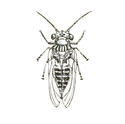|
Sternorrhyncha
The Sternorrhyncha[1][2][3] suborder of the Hemiptera contains the aphids, whiteflies, and scale insects, groups which were traditionally included in the now-obsolete order "Homoptera". "Sternorrhyncha" refers to the rearward position of the mouthparts relative to the head. Distributed worldwide, all members of this group are plant-feeders, many considered pests feeding on major crops and ornamental plants. Many exhibit modified morphology and/or life cycles, including phenomena such as flightless morphs, parthenogenesis, sexual dimorphism, and eusociality. PhylogenyThe phylogeny of the extant Sternorrhyncha, inferred from analysis of small subunit (18S) ribosomal RNA, is shown in the cladogram.[citation needed]
The evolutionary position of several fossil taxa are unclear. A suggested phylogeny is:[4][5] GroupsWell-known groups in the Sternorrhyncha include:
References
External linksWikimedia Commons has media related to Sternorrhyncha. |
||||||||||||||||||||||||||||||||||||||||||||||||||||||
Portal di Ensiklopedia Dunia




